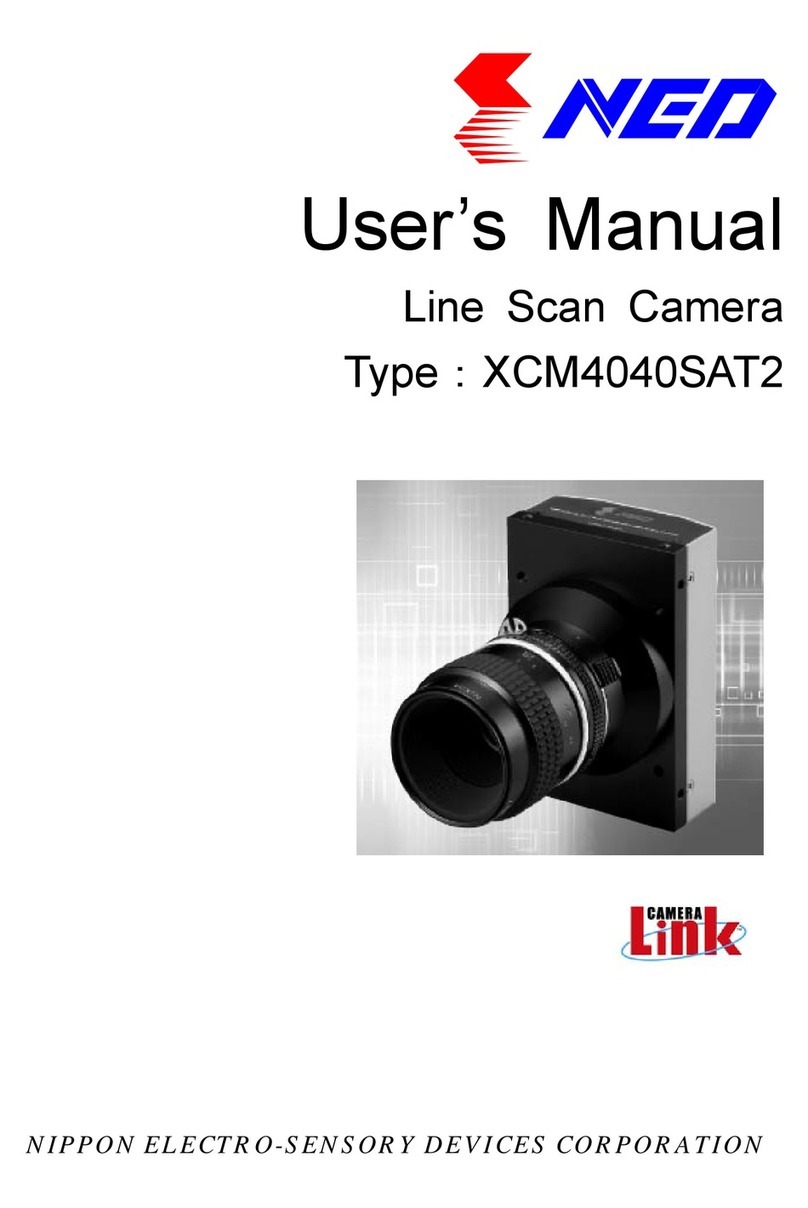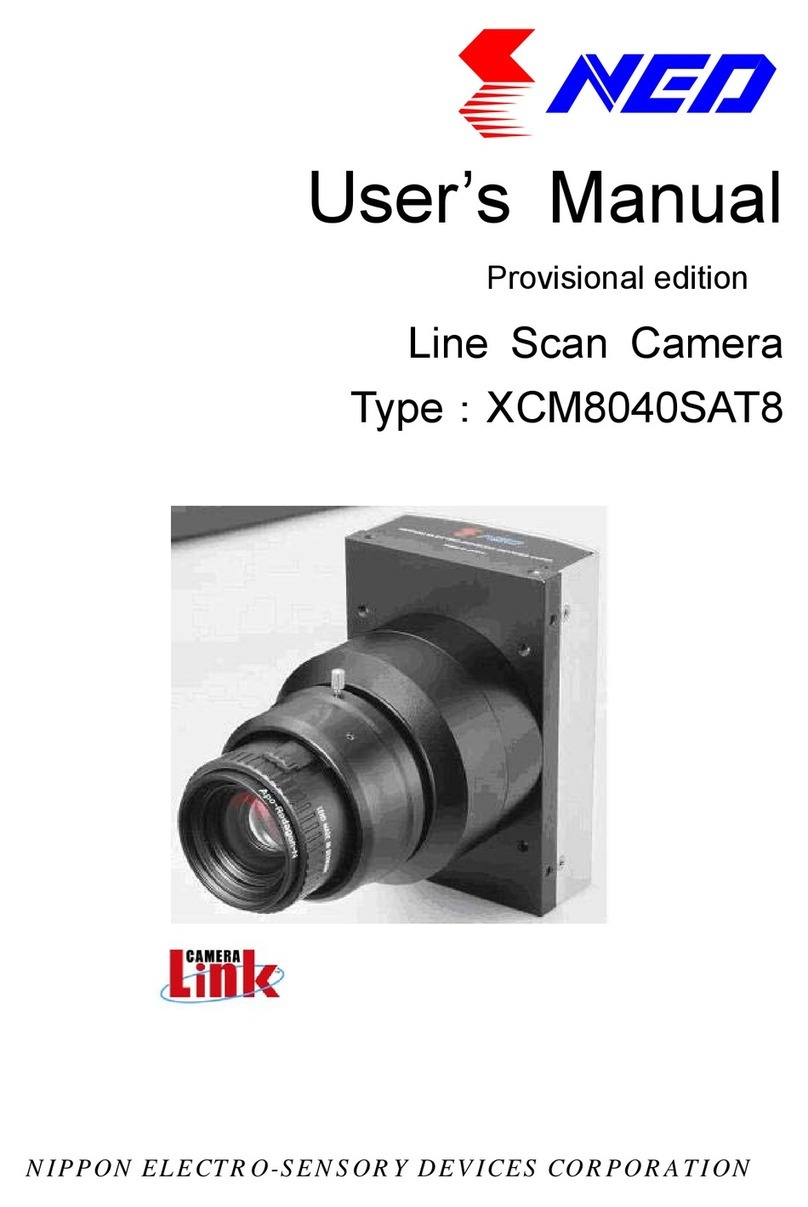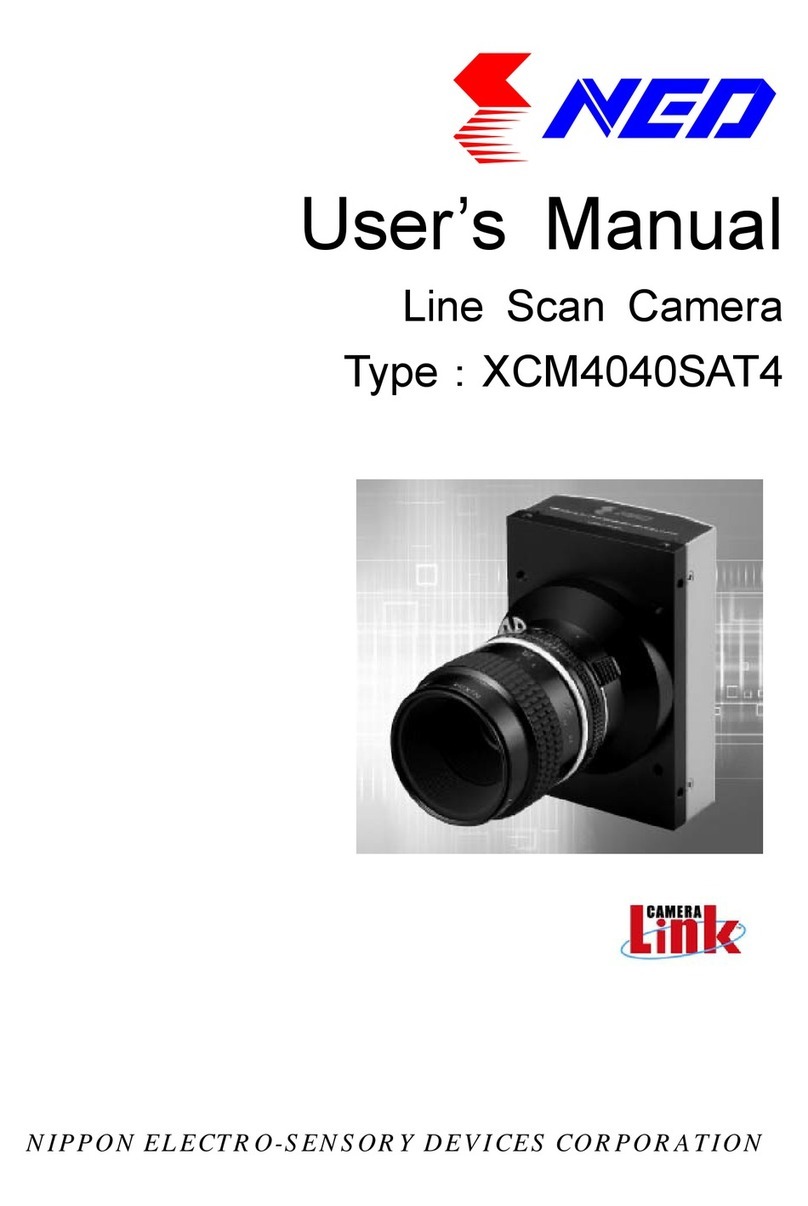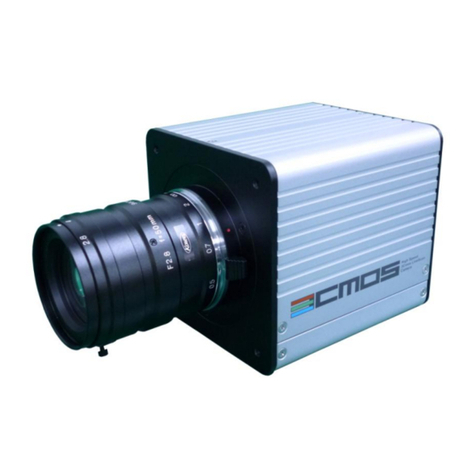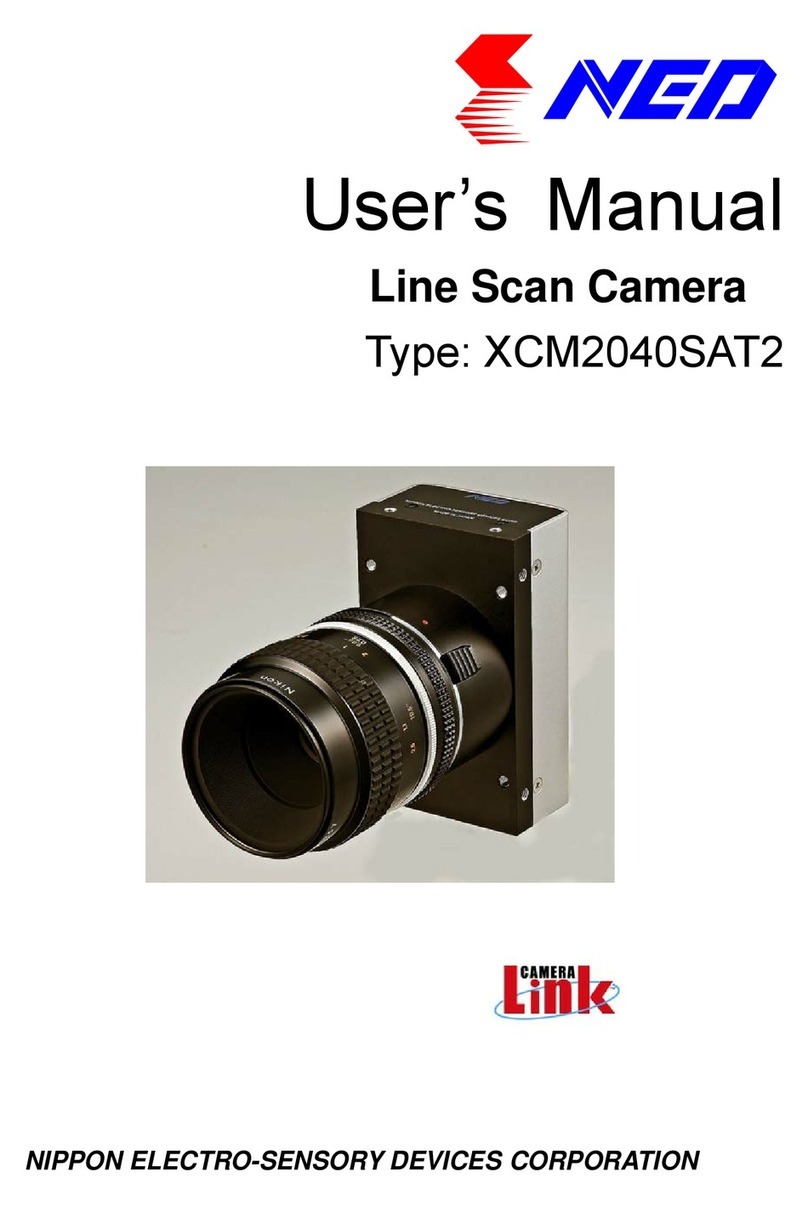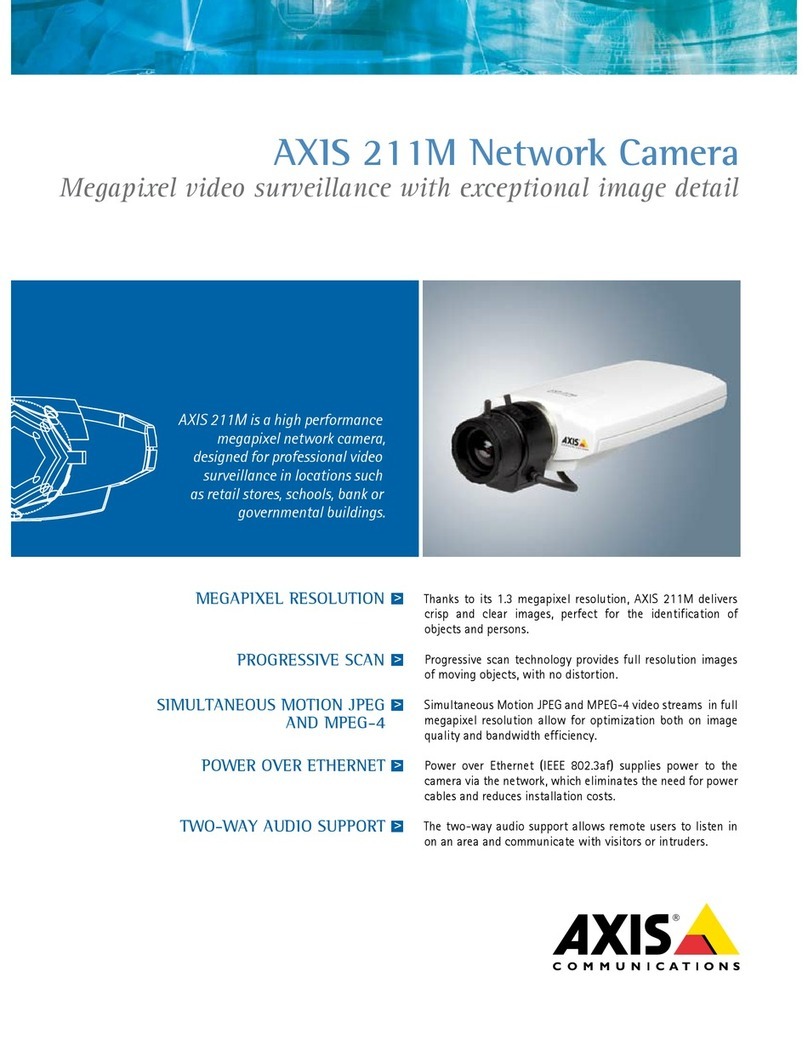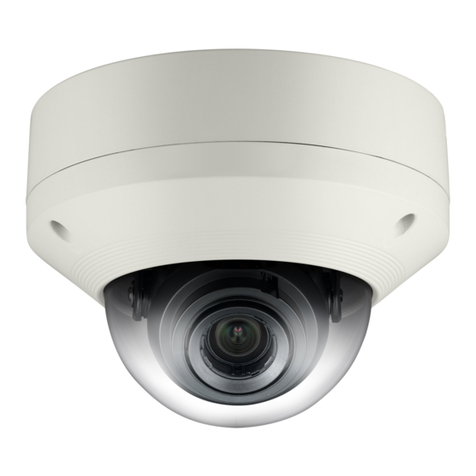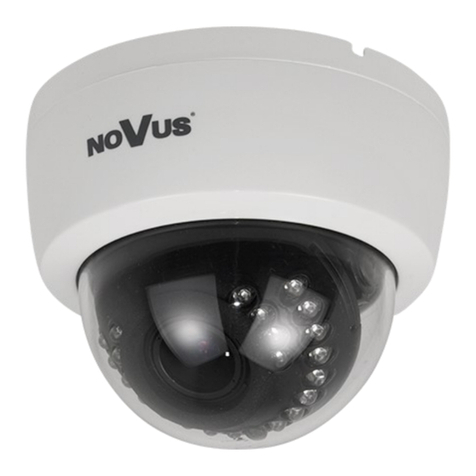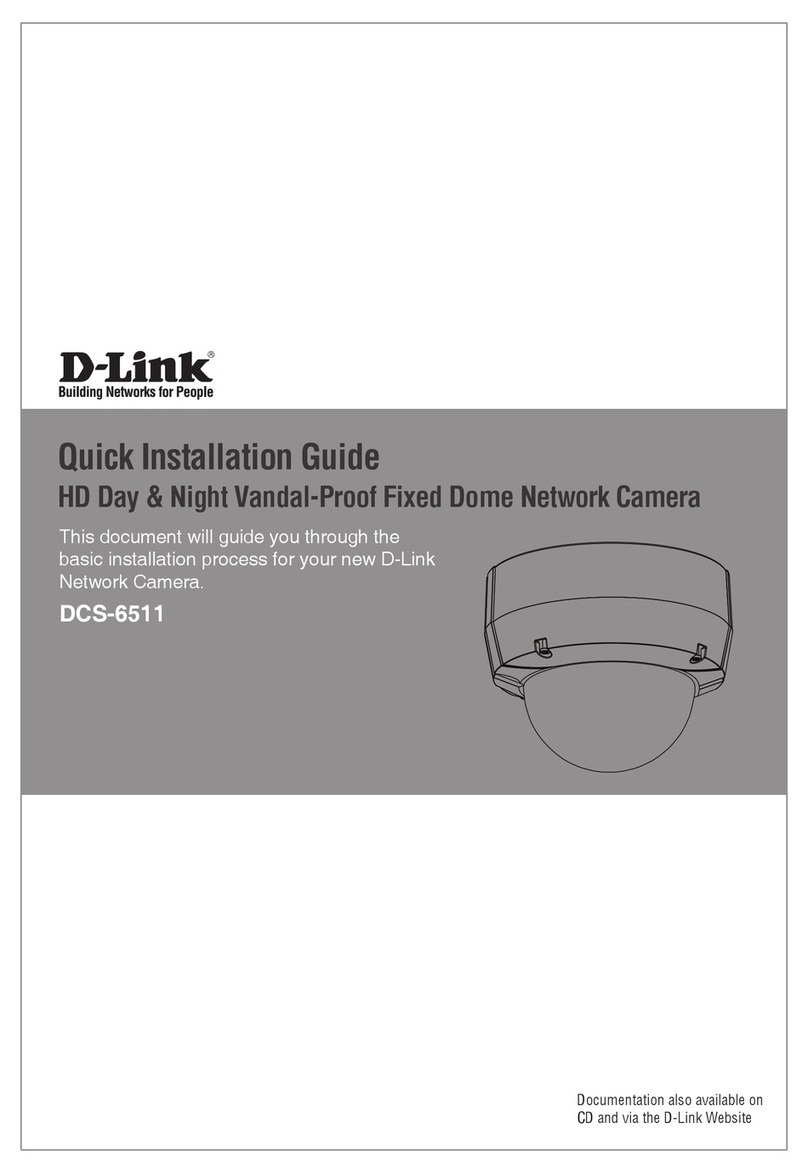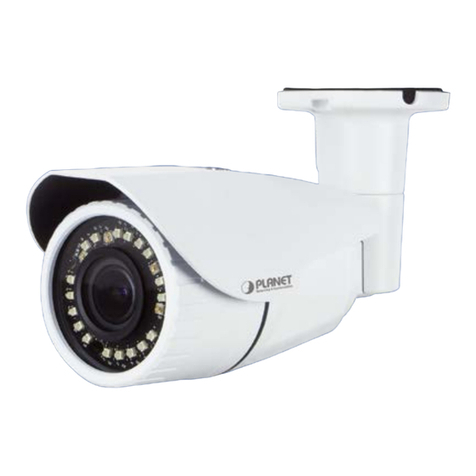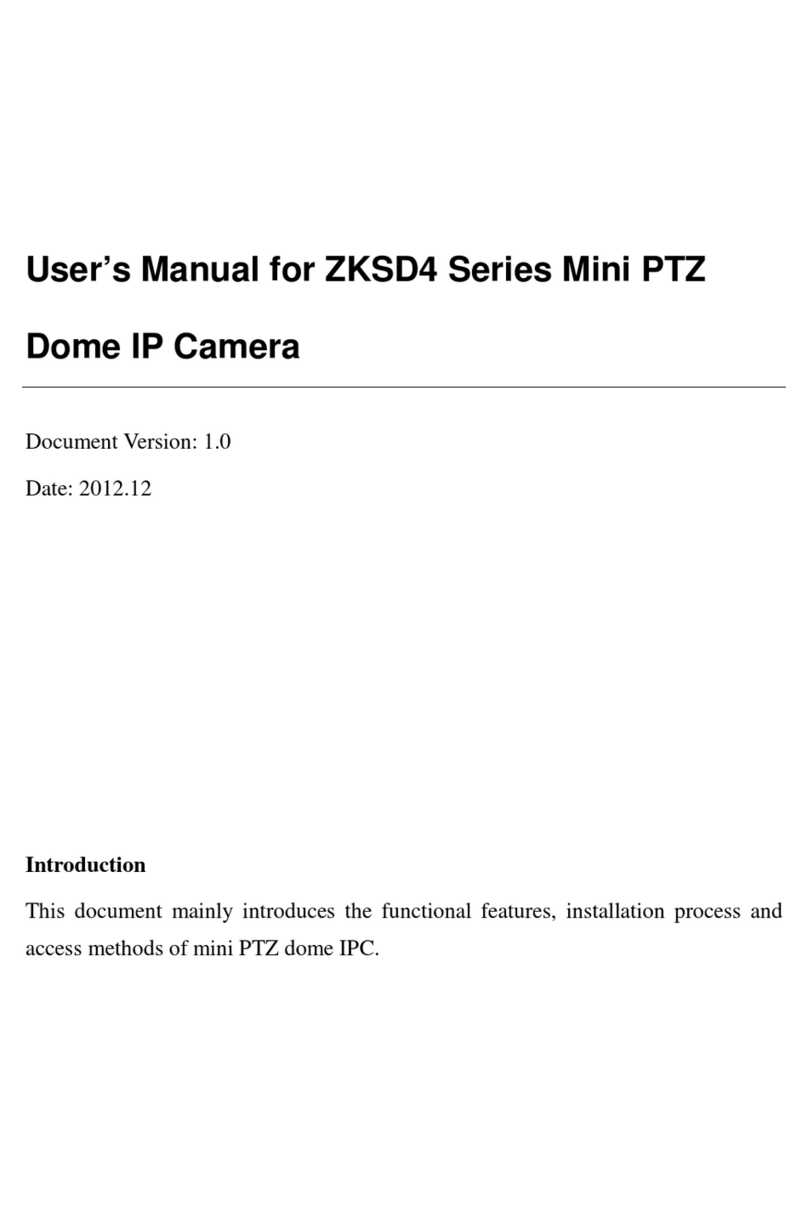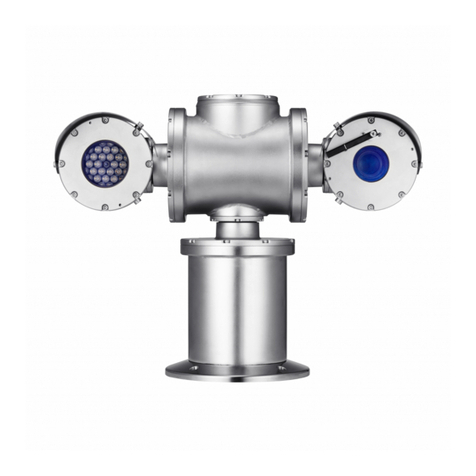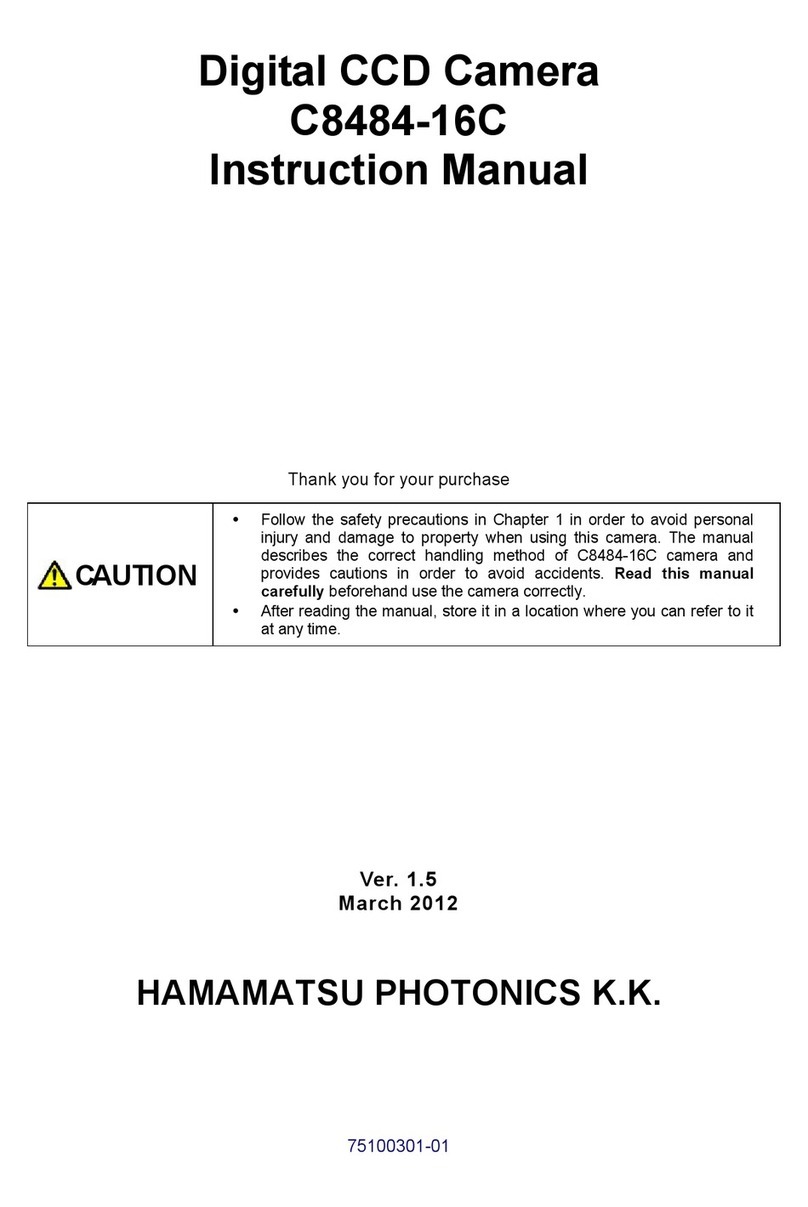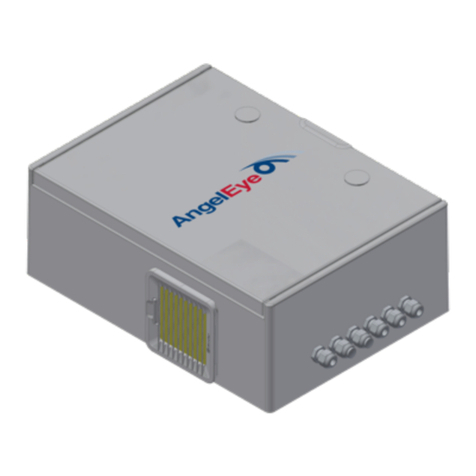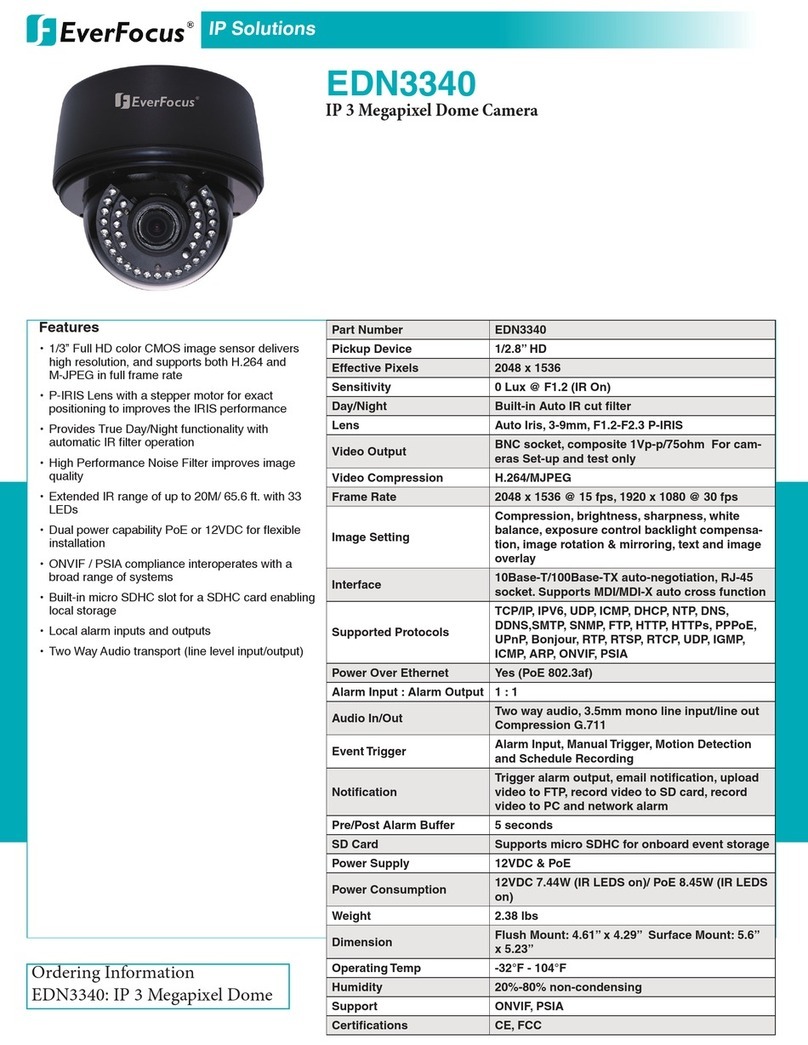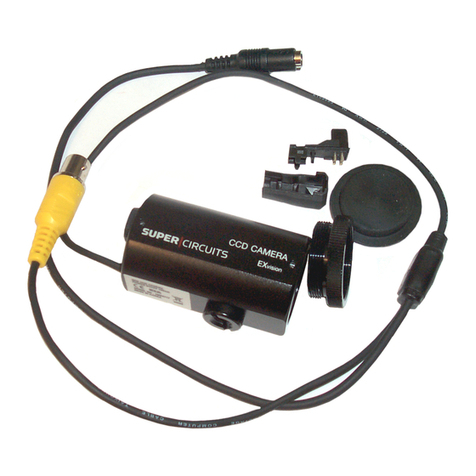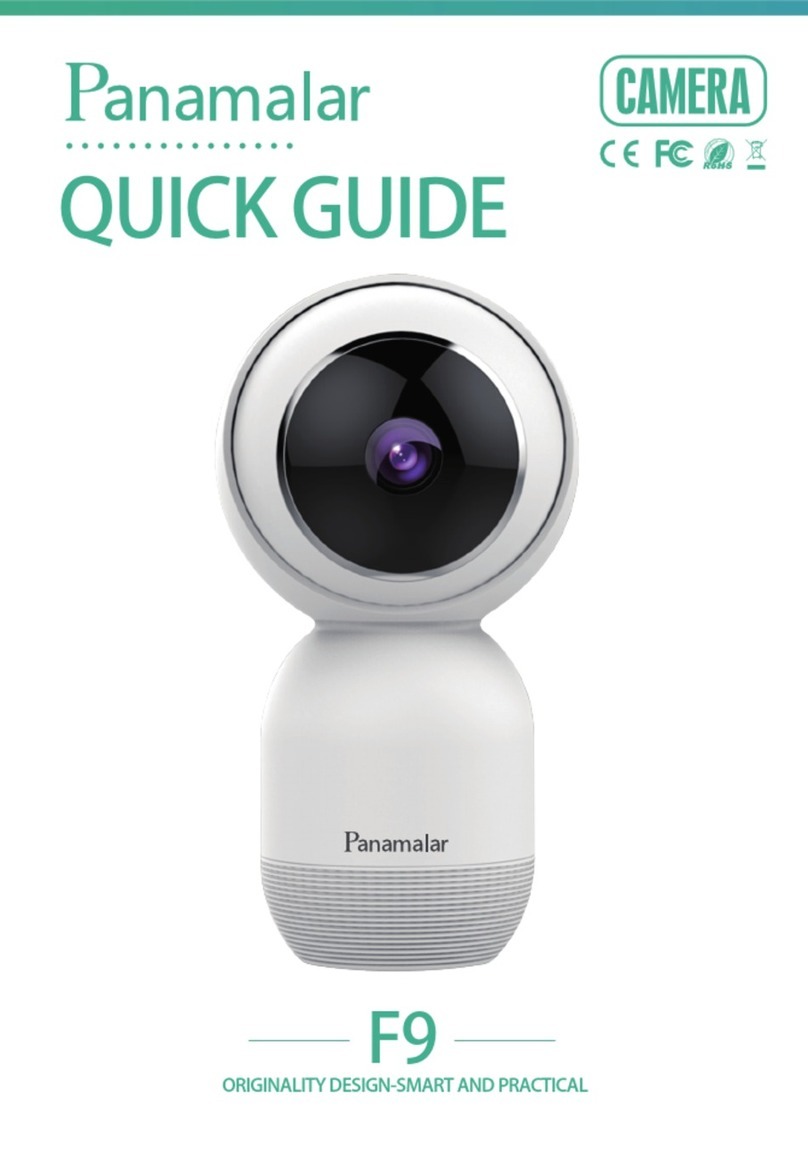NED SU2020 User manual

User’s Manual
Line Scan Camera
Type:SU2020/SU2025
NIPPON ELECTRO-SENSORY DEVICES CORPORATION

NED
SU2020/SU2025 UME-0021-03
2
For Customers in U.S.A.
This equipment has been tested and found to comply with the limits for a Class A
digital device, in accordance with Part 15 of the FCC Rules. These limits are
designed to provide reasonable protection against harmful interference when the
equipment is operated in a commercial environment. This equipment generates, uses,
and can radiate radio frequency energy and, if not installed and used in accordance
with the instruction manual, may cause harmful interference to radio communications.
Operation of this equipment in a residential area is likely to cause harmful
interference, in which case the user will be required to correct the interference at his
or her own expense.
For Customers in the EU
This equipment has been tested and found to comply with the essential
requirements of the EMC Directive 2004/108/EC, based on the following
specifications applied:
EU Harmonised Standards
EN55022:2010 ClassA
EN61000-6-2:2005
Warning
This is a class A product. In a domestic environment this product may cause radio
interference in which case the user may be required to take adequate measures.
Directive on Waste Electrical and Electronic Equipment (WEEE)
Please return all End of Life NED products to the distributor from whom the product
was purchased for adequate recycling and / or disposal. All costs of returning the
Product to NED are borne by the shipper.

NED
UME-0021-03 SU2020/SU2025
3
Introduction
Thank you for purchasing NED’s Line Scan Camera. We look forward to your
continued custom in the future.
For safety use
For your protection, please read these safety instructions completely before
operating the product and keep this manual for future reference.
The following symbols appear next to important information regarding safe
product handling.
Warning
If the product is not handled properly, this may result in
serious injury or possible death.
Caution
If the product is not handled properly, this may result in
physical injury or cause property damage.
Safety precaution
Warning
Never disassemble or modify this product, unless otherwise specified to do so in
this manual.
When hands are wet, avoid handling this product and do not touch any of the
connection cable pins or other metallic components.
Do not operate this product in an environment that is exposed to rain or other
severe external elements, hazardous gases or chemicals.
If the product is not to be used for an extended period of time, as a safety
precaution, always unplug the connection cable from the camera unit.
If the product installation or inspection must be executed in an overhead location,
please take the necessary measures to prevent the camera unit and its
components from accidentally falling to the ground.
If smoke, an abnormal odor or strange noise is emitted from the camera unit, first
turn OFF power, then unplug the cable from the camera unit.
This product is not intended for use in a system configuration built for critical
applications.

NED
SU2020/SU2025 UME-0021-03
4
Instructions before use
Only operate this product within the recommended environmental temperature
range.
Use only the specified power source and voltage rating.
Do not drop this product. Avoid exposure to strong impact and vibrations.
Install the camera unit in a well-ventilated environment, in order to prevent the
camera from overheating.
If the camera must be installed in an environment containing dust or other
particles, take required measures to protect the camera unit from dust adhesion.
Do not unplug the cable while power is being supplied to the camera unit. To
prevent product damage, always shut down the power supply before unplugging
the power cable.
When the surface of the camera window becomes dirty due to dust or grime,
black smudges appear in the displayed image. Use an air blower to remove the
dust particles. Dip a cotton swab into ethanol alcohol and clean the camera
window. Be careful not to scratch the glass.
Use of non-infrared lighting such as a daylight fluorescent lamp is recommended.
If halogen lighting is employed, always install an infrared filter into your system
configuration.
Please note that exposure to long wavelength light outside of the sensors visible
optical range can affect the image.
Sensitivity may fluctuate depending on the spectral response level of the light
source. In cases like this, changing the light source to one with a different
spectral response level may reduce this problem.
Please note that when the CCD is exposed to excessive quantities of light,
blooming can occur. (this product does not have an Anti-Blooming function)
For stabilized image capturing, turn ON the power supply and execute aging for
ten to twenty minutes before actually using the camera unit.
Do not share the power supply with motor units or other devices that generate
noise interference.
Do not disconnect the camera while rewriting the embedded memory.
When you change the exposure mode that is set at the NED factory, input control
signal (CC1) from the capture board.

NED
UME-0021-03 SU2020/SU2025
5
Product Warranty
Warranty Period
The product warranty period, as a general rule, is two years from purchase;
however for detailed conditions please contact the sales representative for your
region/country.
However, in some cases due to the usage environment, usage conditions and/or
frequency of use, this warranty period may not be applicable.
Warranty Scope
Product repair will be performed on a Return To Manufacturer basis. On-site
maintenance will incur additional charges.
If defects in material or workmanship occur during the warranty period, the faulty
part will be replaced or repaired by us free of charge. Return shipping charges
must be paid by the sender. However, the following cases fall outside of the
scope of this warranty:
Exclusions from Warranty Coverage
We will under no circumstances assume responsibility for the following cases:
damage caused by fire, earthquake, other acts of a third party, other accidents,
negligent or intentional misuse by the user, or other usage under extraordinary
circumstances.
Damages (e.g. loss of business profits, business interruption, etc.) resulting from
use or non-use.
Damages caused by use other than as described in this document.
Damages resulting from malfunction due to a connected device.
Damages resulting from repairs or modifications performed by the customer.
Fault Diagnosis
As a general rule, in the first instance fault diagnosis should take the form of a
telephone call or an email to enable us to assess the circumstances of the
malfunction.
However, depending on the customer’s requests, we, or our agent, may require
an additional fee for this service.

NED
SU2020/SU2025 UME-0021-03
6
Exclusion of Liability for Compensation for Missed Opportunities
Regardless of whether within the warranty period or not, our warranty does not
cover compensation for missed opportunities for our customers, or our
customers’ customers, caused by a fault of our products, nor for damage to
products other than our own, or related business.
Note about Product Usage
This product has been designed and manufactured as a general-purpose product
for general industry. In applications expected to be life-critical or safety-critical,
the installer or user is requested to install double or triple failsafe systems.
Repair Service Outline
The cost of dispatching engineers etc. for repair service is not included in the
price of purchased and supplied goods. On request, arrangements can be made
separately.
Scope of Repair Service
The above assumes business dealings and usage to take place in the
customer’s region / country. In cases of business dealings and/or usage outside
the customer’s region/country, separate consultation is required.

NED
UME-0021-03 SU2020/SU2025
7
Table of Contents
1 Product Outline.........................................................................................10
1.1 Features .....................................................................................................................10
1.2 Applications...............................................................................................................10
1.3 Image Sensor.............................................................................................................12
1.4 Performance Specifications.....................................................................................12
2 Camera Setting and Optical Interface......................................14
2.1 Setting Camera..........................................................................................................14
2.2 Fixing Camera............................................................................................................14
2.3 Camera dimension....................................................................................................15
2.4 Optical Interface........................................................................................................16
3 Hardware........................................................................................................17
3.1 Camera Connection..................................................................................................17
3.2 Input / Output Connectors and Indicator................................................................18
3.3 Connectors・Pin Assignments・Cables ...................................................................19
3.4 Power Supply.............................................................................................................22
4 Camera Control.........................................................................................23
4.1 Flow of Camera Control............................................................................................23
4.1.1 Command Overview...........................................................................................23
4.1.2 Command Format (PC to Camera Transmission)........................................... 23
4.1.3 Reply Format (Camera to PC Transmission)...................................................24
4.1.4 Camera Control Commands.............................................................................. 25
4.1.5 Memory Setup Values (Factory Settings)........................................................ 25
4.2 Details on Commands ..............................................................................................26
4.2.1 Setting Gain.........................................................................................................26
4.2.2 Setting CDS Gain................................................................................................ 26
4.2.3 Setting Offset...................................................................................................... 26
4.2.4 Switching video output......................................................................................27
4.2.5 Switching trigger mode .....................................................................................27
4.2.6 Memory Save ......................................................................................................27
4.2.7 Memory Load ...................................................................................................... 27
4.2.8 Memory Initializing (Initializing Camera Settings)..........................................28
4.3 Startup........................................................................................................................28
4.4 Saving and Loading Camera Settings....................................................................28

NED
SU2020/SU2025 UME-0021-03
8
4.5 Serial Communication Settings...............................................................................29
4.6 Video Output Format ................................................................................................30
4.7 Exposure Mode and Timing Chart...........................................................................31
4.7.1 Free Run Mode....................................................................................................31
4.7.2 External Trigger (ExTrg) Exposure Mode ........................................................ 32
4.8 Setting Offset.............................................................................................................32
4.9 Setting Gain...............................................................................................................33
5 Confirming Camera Settings..........................................................34
5.1 Before Power-on .......................................................................................................34
5.2 After Power-on...........................................................................................................35
5.3 During Operation.......................................................................................................37
6 Sensor Handling Instructions........................................................38
6.1 Electrostatic Discharge and the Sensor.................................................................38
6.2 Protecting Against Dust, Oil and Scratches ..........................................................38
6.3 Cleaning the Sensor Window ..................................................................................38
7 Troubleshooting.......................................................................................39
7.1 No Image....................................................................................................................39
7.2 Noise on Image..........................................................................................................41
7.3 Camera becomes hot................................................................................................43
8 NCCtrl...............................................................................................................44
8.1 Overview ....................................................................................................................44
8.2 System Requirements ..............................................................................................44
8.3 Install..........................................................................................................................45
8.4 Uninstall .....................................................................................................................45
8.5 Operation ...................................................................................................................45
8.5.1 General description............................................................................................45
8.5.2 Starting NCCtrl....................................................................................................46
8.5.3 Open the control setting file.............................................................................. 47
8.5.4 Selecting interface and Timeout setting..........................................................47
8.5.5 Connect ............................................................................................................... 50
8.5.6 Disconnect and exit program............................................................................ 50
8.5.7 Check the contents of communication............................................................51
8.5.8 Export Parameters to text file ...........................................................................51
8.5.9 Import Parameters from text file.......................................................................52

NED
UME-0021-03 SU2020/SU2025
9
8.6 Control........................................................................................................................52
8.6.1 Gain and Offset................................................................................................... 53
8.6.2 Clock, Video output, Video shift, Exposure mode..........................................54
8.6.3 Exposure time.....................................................................................................54
8.6.4 Binning ................................................................................................................ 54
8.6.5 Camera Memory.................................................................................................. 54
8.6.6 Calibration........................................................................................................... 55
8.6.7 Level Correction................................................................................................. 55
8.6.8 Test Pattern......................................................................................................... 55
8.6.9 Line Delay............................................................................................................56
8.7 Software Upgrades....................................................................................................56
8.7.1 NCCtrl upgrades.................................................................................................56
8.7.2 Adding/Replacing control setting file............................................................... 56
8.7.3 Adding/Replacing the interface Plug-in...........................................................56
8.8 Data Transmission Programming............................................................................56
8.9 NCCtrl Troubleshooting............................................................................................57
8.9.1 You can not change the exposure time with NCCtrl....................................... 57
8.10 Attention on use......................................................................................................57
9 Others...............................................................................................................58
9.1 Notice..........................................................................................................................58
9.2 Contact for support...................................................................................................58
9.3 Product Support........................................................................................................59
Revision History...............................................................................................60

NED
SU2020/SU2025 UME-0021-03
10
1 Product Outline
1.1 Features
High speed readout(25MHz:SU2025,20MHz:SU2020)
High resolution(2048 pixels)
Single power source DC12V for operation
Easy connection with a variety of frame grabber boards via Camera Link
interface
Easy control of gain / offset / video output (8-/10-bit) with external software.
High responsivity and low noise
Flat-field correction - minimizes lens vignetting, non-uniform lighting and
sensor FPN and PRNU
Low power consumption (20% decrease from NED old camera)
1.2 Applications
Inspection of Transparent panels and PCBs
Inspection of high speed moving objects
Flat panel display inspection
Inspection of glass and sheet-like objects
Printed circuit board inspection
This camera utilizes an Intelligent Transportation System
Outdoor surveillance

NED
UME-0021-03 SU2020/SU2025
11
An example of Visual Inspection of PCBs is shown below.
Figure 1-2-1 Visual Inspection of PCBs
Object of inspection (example)
Metallic part of cylinder and conical geometry (surface and roller end face)
・Automobile component ・Architectural reinforcement parts
・Various pin parts
Typical detection item
・chip ・dent ・scratch ・chip of roller end face ・external dimensions
Device specification
1.Camera: Line scan camera of number of 2048 pixels
2. Controller: Dedicated software for PC system
Line scan Camera
Object of inspection
■Example of using of one camera.
(Inspection of only surface)
■Example of using of three cameras.
(Inspection of surface and roller end face)

NED
SU2020/SU2025 UME-0021-03
12
1.3 Image Sensor
The camera uses with a maximum data rate of 25MHz(SU2025)・20MHz(SU2020)
to acquire high responsivity and superior quality images.
The pixel size is 14μmx14μm. SU2025 outputs 2048 pixel data through
25MHz,SU2020 outputs 2048 pixel data through 20MHz.
1.4 Performance Specifications
The Performance Specifications are shown below. Unless otherwise specified,
the data shown is when the camera is operating at the maximum scan rate.
Table 1-4-1 Performance Specifications
Items
Specifications
Number of Pixels
2048
Pixel Size H x V (μm)
14x14
Sensor Length (mm)
28.6
Spectral Responsivity (nm)
400~800 *Peak 567
DataRate (MHz)
SU2025
25 [Fixed]
SU2020
20 [Fixed]
Scan Rate
(μs) / [kHz]
SU2025
88 / [11.4]
SU2020
110 / [9.1]
Saturation Exposure (lx・s) (typically)
**PGA Gain 0dB,Ta=25℃,Daylight Fluorescent Light
0.0555
Responsivity (V/ [lx・s]) (typically)
*Analog 5V Conversion Sensitivity
PGA Gain 0dB,Ta=25℃,
Daylight Fluorescent Light
90
Gain Adjustable Range
0 ~ 21(MAX.30dB In using CDS)
※0.03125dB/STEP
Offset Adjustable Range
(DN)
8 bit/tap
0 ~ 19 ※1LSB/STEP
10 bit/tap
0 ~ 76 ※4LSB/STEP
12 bit/tap
0 ~ 304 ※16LSB/STEP
Video output Camera Link
Format
Camera Link Base line 8,10,12bit
Protocol
Camera Link Base Configuration
PRNU (Photo Response Non Uniformity)
3%
Random Noise (DN)
20 (Minimum gain 10bit)

NED
UME-0021-03 SU2020/SU2025
13
Control Input
CC1: External Synchronizing Signal
[start signal]
Serial communication Control
SerTC、SerTFG
Master Clock (MHz)
*only internal clock
SU2025
50
SU2020
40
Connectors
Data/Controller
3M: MDR26 [Camera Link]
Power Supply
Hirose: HR10A (4Pin)
Lens Mount
Nikon F Mount
Operating Temperature (˚C)
No Condensation
0 to 50
Power Supply Voltage (V)
DC 12 [+/-5%]
Consumption Current (mA) (typically)
270 [DC12V]
Size W x H x D (mm)
64x70x91.7 (*see section 4)
Mass (g) (Camera only)
<410
Special instruction
Camera Link Interface
The spectral Responsivity is shown below.

NED
SU2020/SU2025 UME-0021-03
14
2 Camera Setting and Optical Interface
2.1 Setting Camera
Use the M4 screw holes or the screw hole for a tripod to set the camera.
2.2 Fixing Camera
Use the M4 screw holes (4 places at the front, 8 places at the side) to fix the
camera.
Or use the 1/4"-20UNC screw hole (the screw hole for a tripod, 1 place at the
side) to fix the camera.
If using the front panel M4 mounting holes, the screw length for fixing the camera
should be less than 6mm.
No X-, Y-axis orientation and tilt adjustment mechanism is available. Please
provide an adjustment mechanism yourself as necessary.

NED
UME-0021-03 SU2020/SU2025
15
2.3 Camera dimension
The dimensions for camera are shown below.
59.0+0.0
-0.2
10.0
40.0
FB'=45.0
95.9
36.2 59.7
40.0
1/4"-20UNC(valid depth 6)
screw hole for fixing camera
M4 Depth 6 (4 parts)
50.0
32.0
CCD center pixel
35.0
50.0
CCD中心
CCD 1st Pixel
23.0 12.0
70.0
22.5
Camera Link Connector
10226-2210PE
24.0
64.0
24.0
15.0
LED
Power Supply Connector
HR10G-7R-4PB(73)
DC 12V
NIPPON ELECTRO SENSORY DEVICES CORP.
CAMERA LINK BASE
MADE IN JAPAN
SCAN
screw hole for fixing camera
M4 Depth 6 (8parts)
55.5
45.0
Figure 2-2-1 Dimensions

NED
SU2020/SU2025 UME-0021-03
16
2.4 Optical Interface
The amount and wavelengths of light required to capture useful images depend
on the intended use. Factors include the property, speed, the object’s spectral
characteristics, exposure time, the light source characteristics, the specifications of
the acquisition system and so on.
The exposure amount (exposure time x light amount) is the most important factor
in getting desirable images. Please determine the exposure amount after studying
what is most important to your system.
Keep these guidelines in mind when setting up your light source:
LED light sources are relatively inexpensive, provide a uniform field and
longer life span compared to other light sources. However, they also require a
camera with excellent sensitivity.
Halogen light sources generally provide very little blue relative to infrared
light (IR).
Fiber-optic light distribution systems generally transmit very little blue light
relative to IR.
Metal halide light sources are very bright but have a shorter life span
compared to other light sources.
Generally speaking, the brighter light sources, the shorter life span.
CCD image sensors are sensitive to infrared (IR). We recommend using daylight
color fluorescent lamps that have low IR emissions. If you use a halogen light
source, to prevent infrared from distorting the images use an IR cutoff filter that
does not transmit IR wavelengths.

NED
UME-0021-03 SU2020/SU2025
17
3 Hardware
3.1 Camera Connection
(1) Camera Link cables shall be used to connect the camera unit with the frame
grabber board.
If you use asymmetric Camera Link cables, connect the camera with the
connector labeled as ”Camera side”.
(2) Connect with a power supply.
Use a power cable to connect the camera with the power source for the
camera. Insert the plug end of the cable into the camera. Attach the opposite
end (loose wires) to the power unit.
Other than the above, a personal computer, a frame grabber board, a
photographic lens, a photographic lens mount, a light source and an encoder
are necessary, depending on the situation。
PC
Line Scan Camera
Camera Link Cable
3M:14B26-SZLB-xxx-0LC
Power Cable 10m
DGPS-10
Camera Power Supply
DC+12V
Camera Link
Base Configuration
Frame Grabber Board
Figure 3-1-1 Connections between Camera and Frame Grabber Board and Power Supply
There are two connectors available for the Camera Link Medium Configuration
board. Always check the frame grabber board specifications before making
connections.

NED
SU2020/SU2025 UME-0021-03
18
<Note: Choosing the appropriate Camera Link cable length >
According to the Camera Link Specification, the maximum cable length is 10m. But
the maximum cable length to be able to transfer data depends on the type of cable
performance and clock speed. The actual maximum transmission distance becomes
less than 10m at faster clock speeds, though the transmission distance of 10m is
feasible at slower clock speeds.
The following table shows values being calculated in accordance with the Camera
Link Specification 2007.Version1.2., using a typical cable (14B26-SZLB-xxx-0LC from
3M) and frame grabber board (Solios from Matrox). Please choose the appropriate
Camera Link cable type and length for your application. We recommend you perform
a connection test in advance.
Table 3-1-1 calculated value of maximum cable length
Solios model
clock speed(MHz)
maximum cable length (m)
SOL 6M CL E*
(20~66MHz)
40
9.8
66
8.0
SOL 6M FC E*
(20~85MHz)
75
7.6
85
5.8
3.2 Input / Output Connectors and Indicator
The layout of input /output connecters and the indicator lamp are as follows.
+12V Power Indicator
Power Connector
MDR26 Connector
CAMERA LINK BASE
MADE IN JAPAN
NIPPON ELECTRO SENSORY DEVICE CORP.
SCAN
Figure 3-2-1 Input/Output Connectors and Indicator

NED
UME-0021-03 SU2020/SU2025
19
3.3 Connectors・Pin Assignments・Cables
This camera uses the Base Configuration of Camera Link interface standards.
The figure shown below shows the interface for the camera and a typical
implementation for the frame grabber interface.
28 28
Frame Grabber BoardCamera
26-pin MDR Connector
CC1(control input)
Cable
SerTC
SerTFG
CK25MHz
Channel Link Bus
LVAL,FVAL
DVAL,SP
CD0~CD11
CC2
CC3
CC4
X1±
X0±
X2±
X3±
XClk±
100Ω
100Ω
100Ω
100Ω
100Ω
100Ω
100Ω
100Ω
100Ω
100Ω
100Ω
SerTFG±
SerTC±
CC1±
CC2±
CC3±
CC4±
26-pin MDR Connector
X1±
X0±
X2±
X3±
XClk±
SerTFG±
SerTC±
CC1±
CC2±
CC3±
CC4±
LVDS_DRIVER(NS)
DS90CR285MTD
equivalent
LVDS_DRIVER/
RECEIVER(NS)
DS90LV019TM
equivalent
LVDS_RECEIVER(NS)
DS90LV048AT
equivalent
LVDS_RECEIVER(NS)
DS90CR286MTD
recommended
LVDS_DRIVER/
RECEIVER(NS)
DS90LV019TM
recommended
LVDS_DRIVER(NS)
DS90LV047AT
recommended
Figure 3-3-1 Camera / Frame Grabber Interface
Set the LVDS, Channel Link receiver side to 100-ohm termination.
With the driver side of LVDS, even if not used, do not make it open but set the
logic to H or L.
Figure 3-3-2 Circuit of LVDS
The camera has 26-pin MDR connectors for control signals of Camera Link, data
signals and serial communications. The camera also has a 4-pin HIROSE
connector for power supply.
+
-
100Ω
+
-
Driver Receiver
H or L

NED
SU2020/SU2025 UME-0021-03
20
Figure 3-3-3 Camera Link Connector
Half pitch (miniature half ribbon) shape
Locking screw (UNC #4-40) type
Table 3-3-1 Camera Link Connector (26-pin MDR Connector) pin assignments
No
NAME
No
NAME
I/O
1
Inner Shield
14
Inner Shield
2
X0-
15
X0+
Out
3
X1-
16
X1+
Out
4
X2-
17
X2+
Out
5
Xclk-
18
Xclk+
Out
6
X3-
19
X3+
Out
7
SerTC+
20
SerTC-
In
8
SerTFG-
21
SerTFG+
Out
9
CC1-
22
CC1+
In
10
CC2+
23
CC2-
In
11
CC3-
24
CC3+
In
12
CC4+
25
CC4-
In
13
Inner Shield
26
Inner Shield
1
14
2
15
3
16
11
24
12
25
13
26
This manual suits for next models
1
Table of contents
Other NED Security Camera manuals

